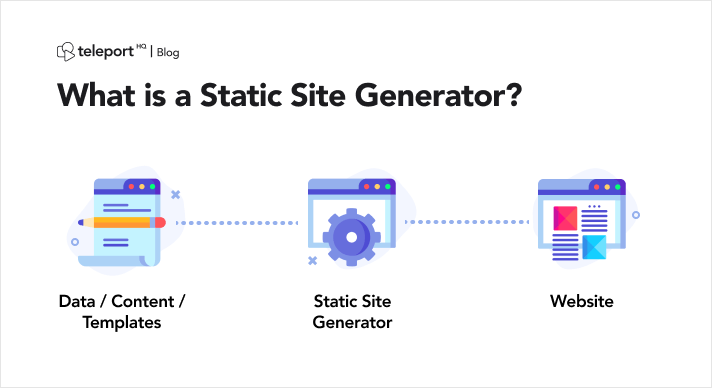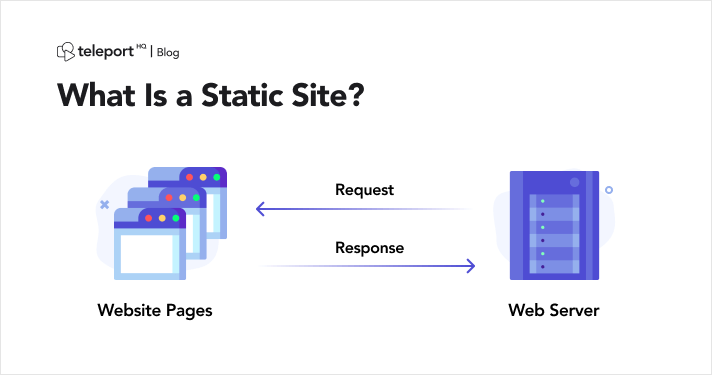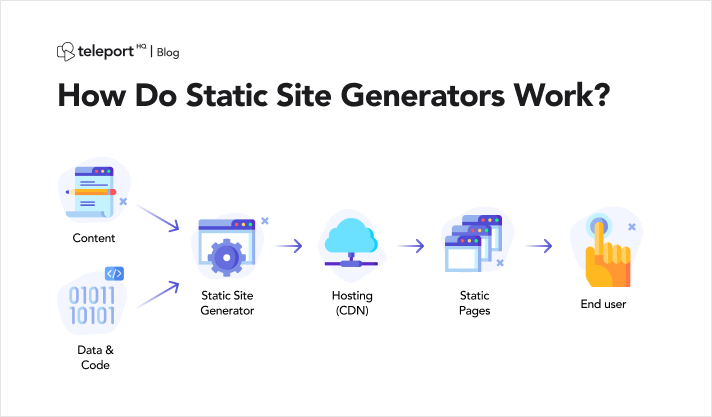In the last few years, the world has turned digital, and with it, there is a high demand in the web development industry for creating websites suitable for each brand, product, and basically anything you can think of.
In order to increase efficiency, the same industry found solutions for keeping up with the creation and maintenance of the websites.
This is where static site generators come to everybody’s help.
They’re meant to streamline the entire website creation process by generating pages that otherwise need to be manually implemented through coding.
Today we’ll go through everything there is to know about static site generators and the great benefits they bring.
Let’s get right to it.
A. What Is a Static Site Generator?
A static site generator (SSG) is used to build static sites based on a set of HTML files deployed to an HTTP server. This tool is used to automate the task of coding each HTML page.

The content from a static site generator is in the form of text-based files, which are huddled together into HTML pages through templates. Once the website is rendered, it gets uploaded to a global CDN, making these prebuilt pages load fast in users’ browsers.
Static site generators are a great alternative to content management systems (CMS), but unlike a CMS, an SSG doesn’t require a database or server-side rendering for execution.
The content from a CMS has to correspond with the fields served by the CMS database in order to appear correctly on the website every time.
A static site generator allows developers to use templates to generate static websites, but unlike a CMS, they are rendered ahead of time, not as a response to a user’s request. This helps in web sites speed and increased customization for developers, who are not limited by the database served by the CMS.
Because we’re talking about static site generators, we should also mention a bit about what a static website is.
B. What Is a Static Site?
A static website is built out of one or more HTML pages pre-rendered using specific layouts cached and delivered through a content delivery network (CDN). Because they are pre-rendered, they’ll load very fast and appear the same way every time for all the visitors.

On the other hand, a dynamic website loads differently for every user, based on their location, time of the day, or other user actions. Dynamic websites process these requests and get information from an external database or a content management system (CMS). This type of website requires the execution of JavaScript code within the browser in order to render.
If you want to read a more in-depth take on these two types of websites, check out our article on what are the differences between static and dynamic websites.
C. How Do Static Site Generators Work?

A static site generator works based on simplicity that leads to fast processes.
At build time, a static site generator or framework reads content from files before that content reaches the CDN.
Then, the content gets rendered to HTML based on the templates and sent to the CDN, where the results will correspond with the source files. These files will remain in there ready for when requests on the content are made.
Static site generators are also used together with a framework, which is a prebuilt code with a collection of files and folders that will help set up a website so that a developer will get a fully functional website or application.
D. Why Use a Static Site Generator?
Because more and more enterprises, brands, or even individuals prefer static websites due to their security and rendering speed, static site generators are becoming more popular.
Developers also enjoy the expanded design options and the ease of using a static site generator. Therefore, creating a static web page using a static site generator improved significantly over the years.
Take our platform, for example. Thanks to the simplicity of using such a static HTML code generator, which offers highly customizable static website templates, your future website can be personalized and ready in no time.
Moreover, developers created tools for different languages and environments, depending on their preferred programming language. This means that the best framework for static websites is the one you enjoy most working with.
If you’re a developer using TeleportHQ, you’ll have, among others, a Gatsby, Angular, or React static site generator, as you’ll be able to export your code generated by our platform and continue working on your project.
So, besides these already mentioned advantages that come with a static site generator, let’s see some other major benefits that will change the way you work.
E. Benefits of Using a Static Site Generator
The core benefit of a static site generator is automating the otherwise individually coding each HTML page. This is already a huge asset, and with it come more benefits.
1. Customization
As I mentioned previously, a static site allows higher customization. Because of this, developers can create any kind of template to include in a static site generator. The situation would be different for a dynamic website, where the CMS fields would limit them.
2. Security
Static website generators create static sites, as their name implies. These websites are served from a simplified web server or a content delivery network (CDN), making up for faster loading speed and increased security.
Fewer servers handling user requests mean fewer possibilities for malicious attacks.
3. Scalability
Because a static HTML is already generated before the request, with all its assets cached in the CDN and served directly, you can rest assured there won’t be additional server requests that need your attention. This is because the caching method ensures an optimized website starting from its framework.
4. Performance
Static sites created with a content generator are loading web pages in advance rather than serving them on demand each time. This method contrasts with the dynamic websites, which work based on a CMS. This is also one big difference between the two types of websites.
Thanks to this build time method which shifted away from the request time option, a static site is ready to serve ahead of time so that the users will enjoy faster website loads.
Wrapping Up
As you've seen, there are many benefits that come with a static site generator. One important one is the simplicity of its process that allows you to have your future static site in no time and with no struggle at all.
If you want to see a static site generator in action, go ahead and give TeleportHQ a try. It's free.



